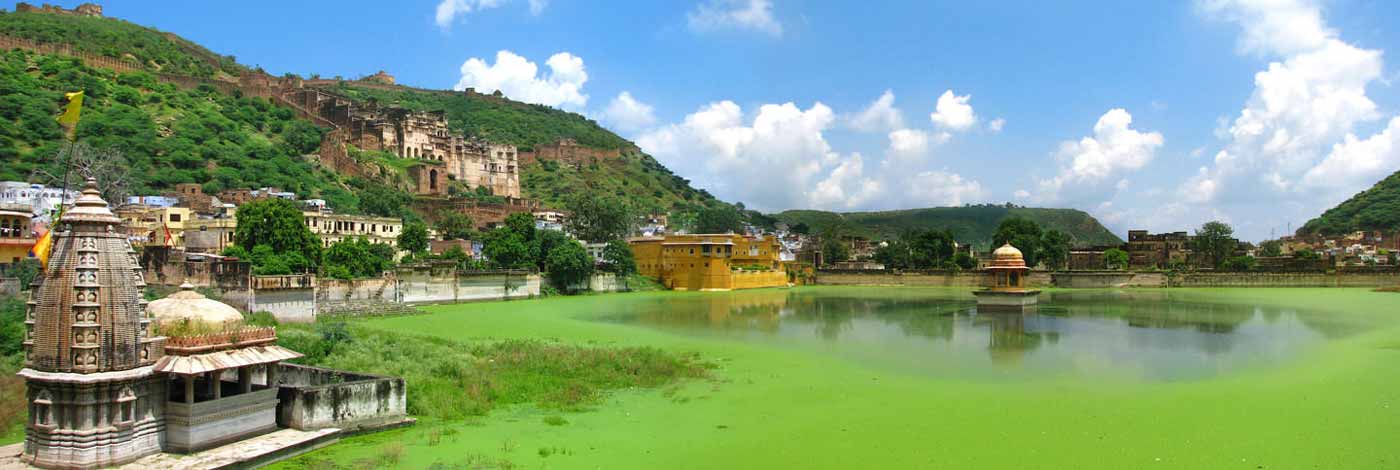History of Bundi
History of Bundi, Rajasthan
Bundi has witnessed the time flow by. Host to countless battles, its forts speak volumes about the district’s rich history. Amidst the desert covered Rajasthan, Bundi is like an Oasis with its rivers, lakes and majestic waterfalls. Being a princely state, the British left them options of forming an independent state, or to be a part of the Union of India or the newly formed country Pakistan, of which their ruler decided to accede to India.
In its early, ancient history, Bundi was home to different tribes, of which, Parihar Meenas were the most powerful. Bundi has gone through changes in its name quite a lot. Being called as Bunda-ka-nal in the early days, it was also named as Haroti, when Rao Deva Hada took over the place from Jaita Meena.
As with most of the olden states, Bundi’s history can be predominantly divided into two parts : Mughal and British. The rulers of Bundi, called Raos, became close allies with Akbar, ever since Rao Surjan gave him the Ranthambore fort. Rao Ratan Singh Hada was a close friend of Jahangir and selflessly supported him during Mughal prince Khurram’s viscous rebellion. The Rao ended up getting his own sons wounded in the efforts.
The Rao during Shah Jahan’s time, Chhattra Sal, was made the governor of Delhi. The relationship between Raos and Mughals became a bit sour when Aurangzeb attacked Bundi to gain control, but his efforts went in vain. Strangely, after the attack Aurangzeb became good friends with the Rao, so much that he fought for him against the valiant hero Shivaji. Rao Buddh Singh didn’t enjoy a peaceful reign either. A bitter feud broke out between him and the Kachwaha rulers. He had to let go of his kingdom many times before dying in exile. It was only the help of Marathas which helped the subsequent Rao to gain the kingdom back.
ut during the twilight of the British kingdom, their relationship with Marathas also became fragile. Accused of treachery, the Raos had to pay heavy tributes to the Marathas until they succumbed to the offer from East India Company to adhere to them, during the reign of one Bishan Singh.
It was Bishan Singh’s son, ‘’Maharao’’ Raja Ram Singh who enjoyed the best years on the throne. Being the ruler for nearly seven decades, Bundi became a striving and prosperous kingdom. With sufficient help from the British, Ram Singh’s era saw the economy ever rising. Although his son accession can be deemed unlucky, as Raghubir Singh had to bear with two disastrous famines, which caused death and a massive diaspora. Raghubir and his successors offered full support to the British during the World Wars.
After going through so many administrative changes, Bundi is now an integral city of Rajasthan, ever since its accession to India after the 1947 post- Independence partition.
Structure of Bundi Fort
A goliath portal invites you to the Bundi Fort. There are three particular portals to enter the fort. These entrances are known as Lakshmi Pol, Phuta Darwaza, and Gagudiki Phatak. The doors are engraved with carvings of elephants. The tunnels in the fort are likewise worth giving a visit. It is fascinating to realize that the tunnels in this powerful fortress had a noteworthy part to play amid times of war since it gave a protected exit to the ruler and his delegates in instances of crises or approaching perils. Unfortunately, tourists are not permitted to enter the passage as there are no far-reaching maps of the tunnels that are accessible. Other than this, the great fort is additionally home to a heap of huge bastions and defenses.
The biggest among these is the sixteenth-century bastion, known as Bhim Burj, on which the monster gun Garbh Gunjan or the ‘Thunder from the Womb’ was once mounted. The Chauhan bastion additionally has some tremendous water supplies, which were worked to store water and supply it to the inhabitants in the midst of an emergency. These supplies have been settled out of a rough base of the fort. The Rani Mahal in the Bundi Fort is likewise a top of the line tourist attraction. The royal residence gloats of its recolored glass windows and wall paintings, which still are enhanced with the appeal of the past period. It additionally houses the well known Miran Sahebki Dargah in its complex. The Bundi Fort offers a magnificent perspective of the whole town and is perfect for bird watching, which makes it celebrated among tourists.

 +91 9799050299
+91 9799050299 


